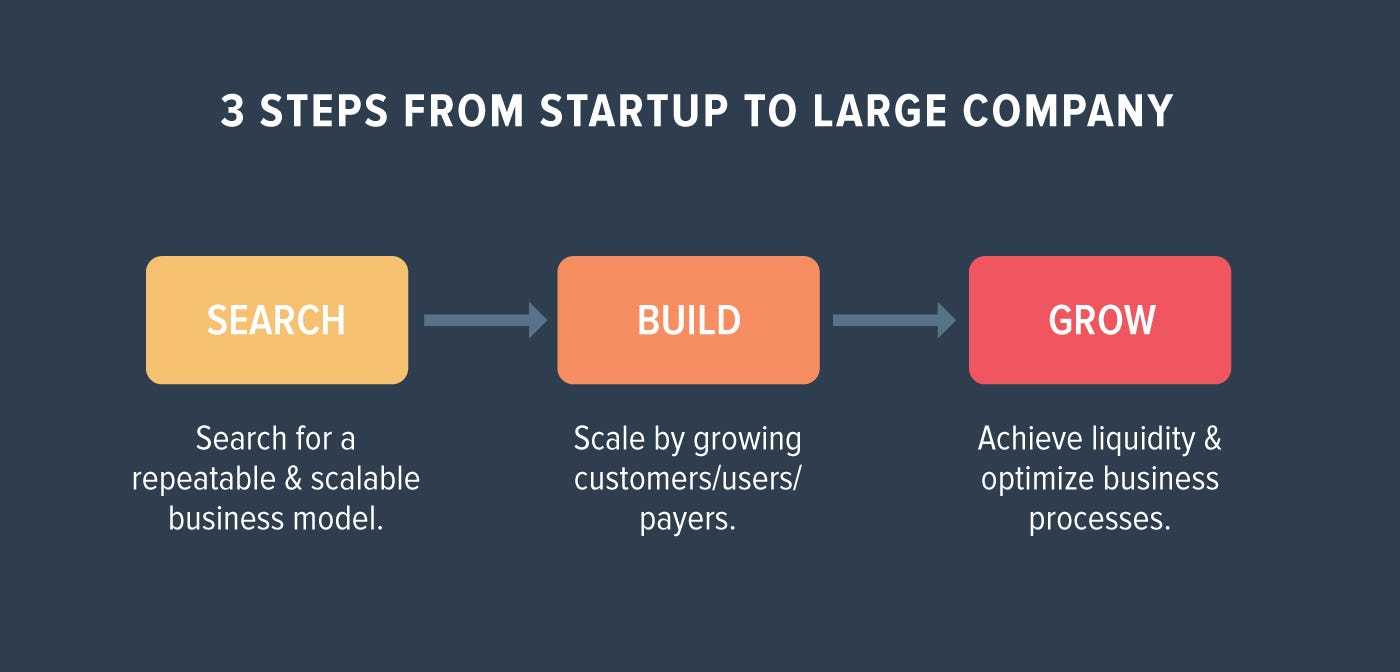'I thought running a business would be hard to start but would get better over time. We've increased our revenue, hired more people, ..., so why am I overwhelmed?' Does this resonate with you as an entrepreneur? This is a common refrain from entrepreneurs wondering how turning their idea into an exciting venture resulted in them wanting to pull out their hair in frustration and working all hours to resolve issues.
According to Steve Blank (the father of modern entrepreneurship), there are 3 stages from startup to a large company:
According to Steve Blank (the father of modern entrepreneurship), there are 3 stages from startup to a large company:
 |
| Steve Blank |
50% of startups fail within 5 years of inception
If your business is at this stage- the search stage- you beat the odds stacked up against you! Most startups fail here because they lack a good product/market fit, have cash flow issues, etc. You will, however, note that your organisation is agile- pivoting in response to changes in the environment- risk-taking; has few processes and does whatever it takes to get the work done. You run on adrenaline!
71% of businesses fail to make it past year 10
In this period, startups move from search to build stages, and while the reasons for failure at this stage are varied, startups tend to grow beyond the capacity of the founder to handle every aspect of the business. Also, their sources of competitive advantage in the search stage i.e. overly customised product/service, founders involvement in everyday tasks, whatever it takes mentality and one centre of power, become their Achilles heel when they progress to the build stage.
Systems and processes
To succeed in the build stage, installation of systems and processes in a startup is vital. Systems and processes allow one to (1) understand clearly how their business operates, (2) tease out the important processes from the unimportant ones, (3) offer a consistent product/service, (4) focus on idea generation and (5) take time off work confident in the knowledge that the business will continue to run in their absence, Yay!
If you are ready to enjoy running your business again, here are a few simple steps to instituting systems and processes in your organisation:
1. Analyse your transformation process
Determine what your inputs are, how you source them, how you transform them into your final product, etc. Ask yourself which of the steps you are taking are working, what's not, how long does it take to move from input to output and what you would change?
2. Evaluate your processes
Analyse your processes and (1) determine their efficacy in achieving your end goal, (2) get rid of processes that add no value to your transformation process (3) reduce the time it takes to complete a process, (4) reduce the number of people needed to complete a process and (5) identify where in the process value is created and whether that value accrues to the customer or the business.
3. Create process maps
These help you identify all the necessary steps in your transformation process and ensure that each process feeds seamlessly into the next. Starting with the desired outcome and working backwards will help in highlighting the necessary processes. When done, compare this to your current processes, look for the most efficient steps and eliminate any unnecessary ones. Write down the process; that way, everyone in the organisation has access to it and can implement it.
4. Test your process
The only way to find out if your process makes sense is to test it and tweak it where the results are not as desired. While testing your process, also decide on which steps in your process can be automated and automate them.
5. Test-run with your employees
This goes without saying. Since your employees are at the forefront of delivering to your clients, train them on how to use the set process map and encourage them to adhere to it to avoid variances in outputs.
6. Systems improvement
A system is a living thing and, therefore, should be adjusted in light of new information. Staff should feel free to suggest changes to the processes.
Note:
1. There is no need to wait until you are in the build stage of your business to implement systems and processes. They can be implemented as soon as you work out your product/service delivery process.
2. The move from search, build, grow is not linear and there are no hard and fast rules about how long a business spends at any of these stages. It very much depends on the nature of the business.
What systems/processes do you have in your business? When did you implement them? If you do not have any, consider looking at implementing them and get in touch if you need help navigating the process.